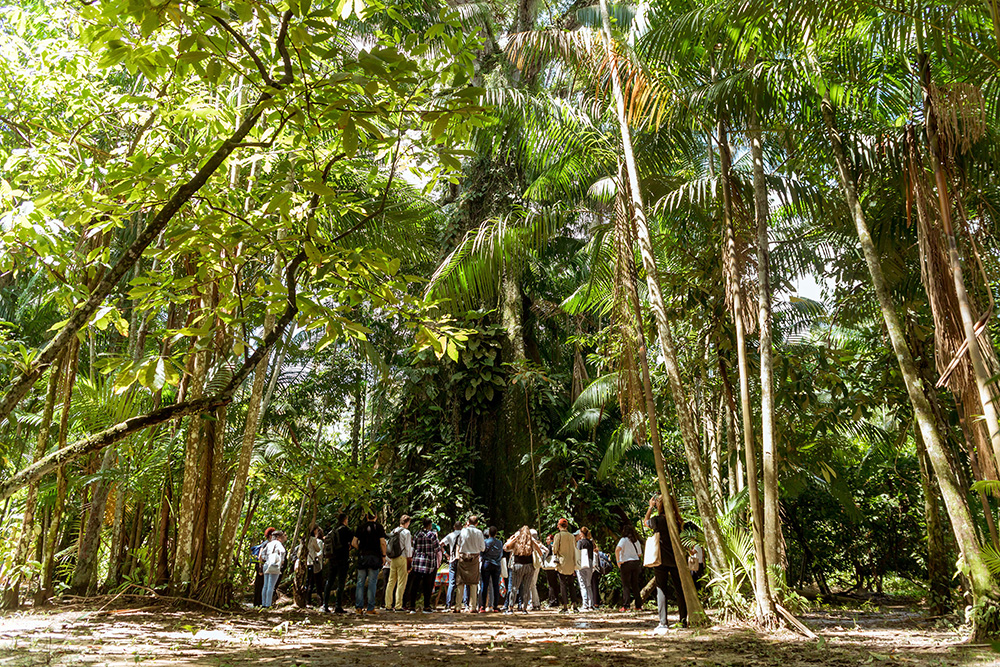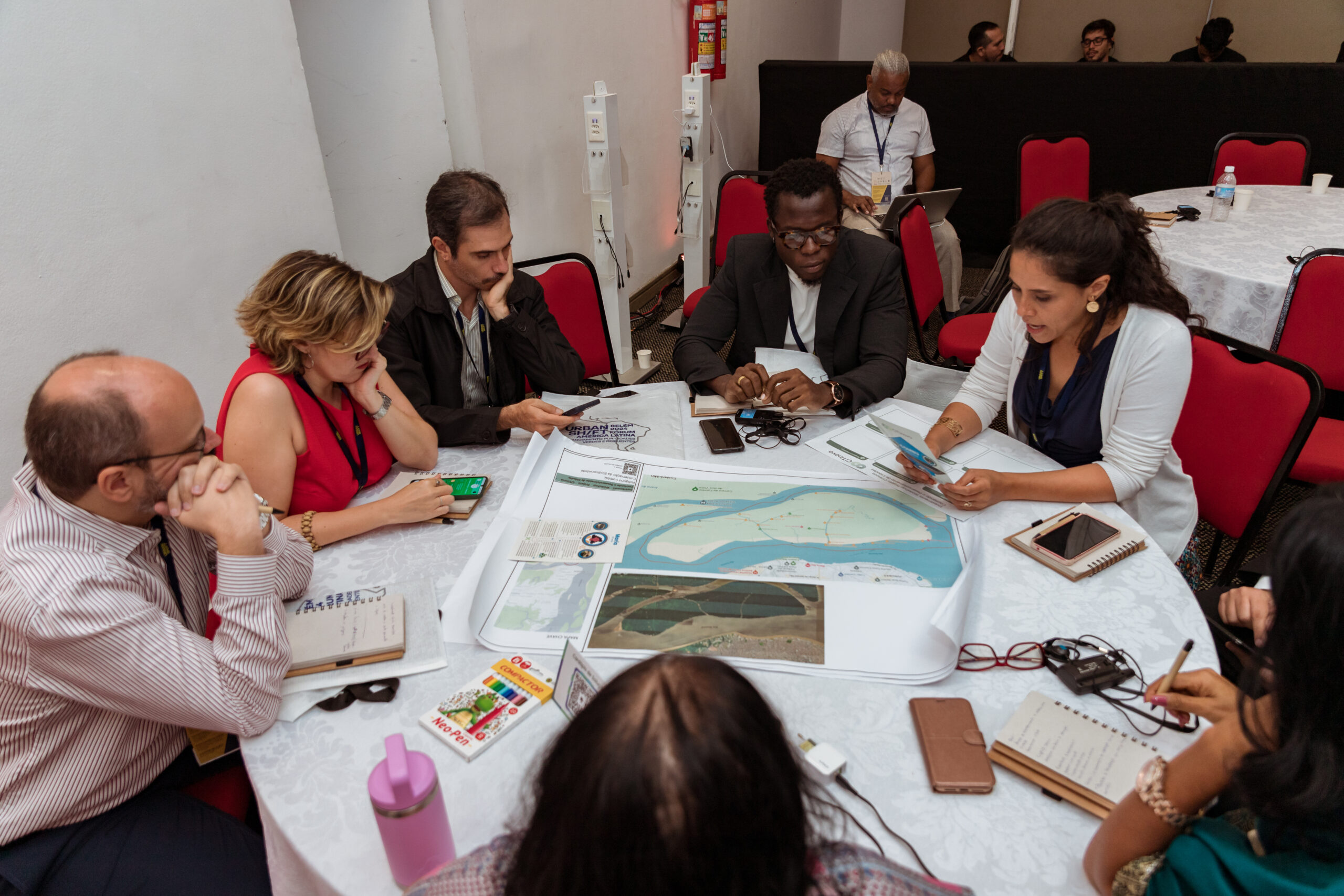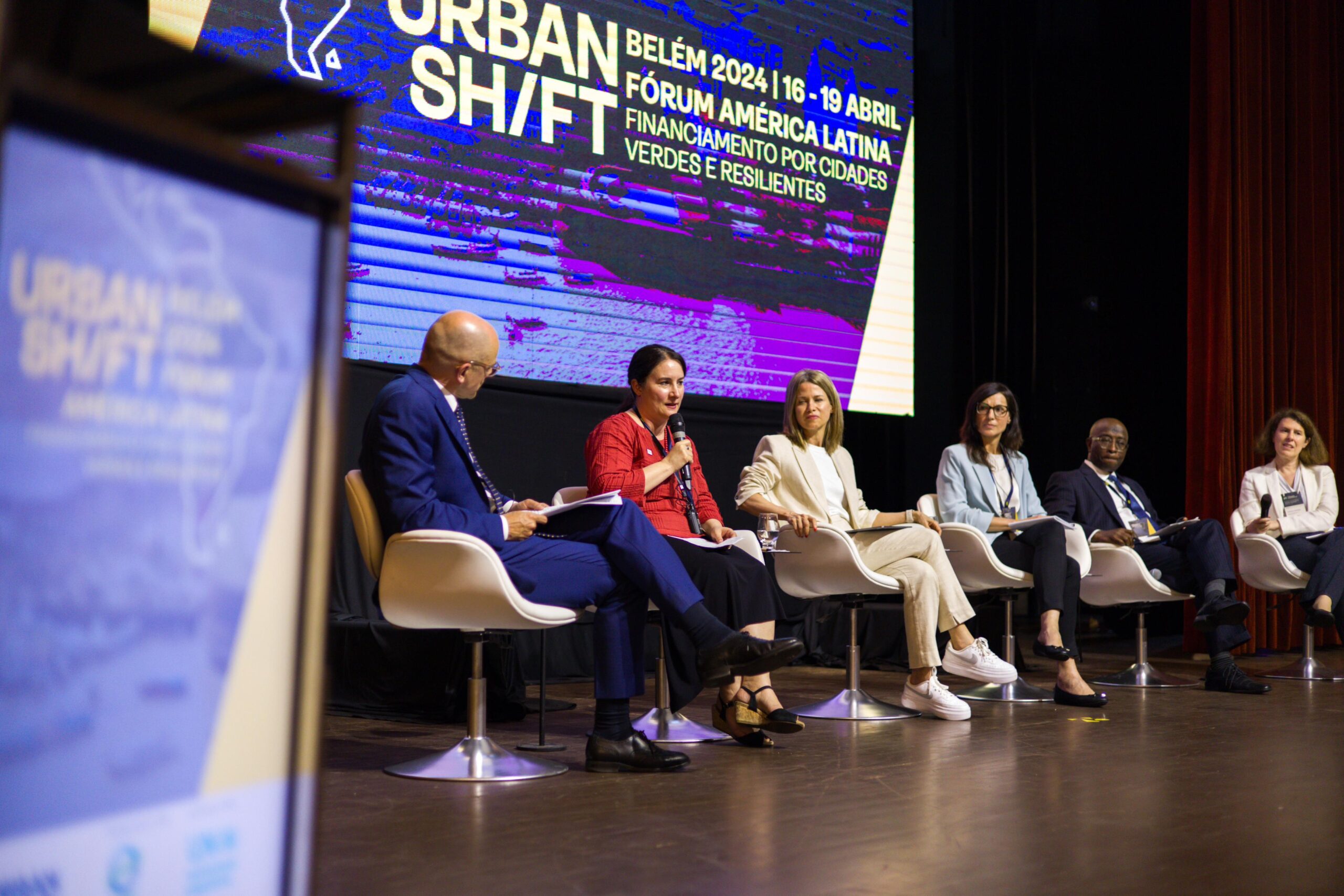
Amid the vast Amazon River delta, Belém, Brazil, sits at the intersection of the urban and natural worlds. A network of waterways and islands home to resources like açaí and cacao surround the city, serving as a critical port for Brazil and the Amazon region. As Belém prepares to host COP30 next year – foregrounding the importance of the region in global climate discussions – the impacts of climate change, from mounting heat to intensifying rainfall, are taking hold in the city.
Against this backdrop, UrbanShift gathered over 250 leaders from 35 countries across Latin America and the Caribbean, alongside peers from Asia and Africa, for the UrbanShift Latin America Forum: four intensive days of collaboration around strengthening financing for green and resilient cities. “We need a discussion on urban climate financing mechanisms. We need to advocate for the inclusion of urban climate finance targets in the global conversation. And we need to champion the role that cities can play in reaching our global climate goals,” said WRI Ross Center for Sustainable Cities Global Director Rogier van den Berg during the Forum’s opening ceremony. The UrbanShift Latin America Forum delivered all three.
Through workshops on public-private collaboration for urban bioeconomies and more sustainable approaches to tourism, deep-dive sessions with investors on urban climate adaptation pipelines, inspiring high-level panels, and three City Academy courses – covering circular economy strategies, accommodating urban growth and accessing urban climate finance – the Forum offered participants tangible tools for strengthening and financing their urban resilience policies and projects.

The Forum will continue to create ripple effects across the UrbanShift network in Latin America as cities apply ideas from the workshops to their local initiatives. Below, we explore three key takeaways from the UrbanShift Latin America Forum.
Climate Finance Strategies Must Center Cities
Despite a projected need of $5.4 trillion per year, cities currently receive only 1% of the climate finance needed to become more resilient in the face of climate change. For projects focused on climate adaptation, financial resources are even more constrained. “Financing must reach the local level – the cities, the city dwellers, the people who suffer with heat waves, who lose their belongings and in the worst cases, their lives,” said Ilan Cuperstien, Regional Director for Latin America for C40 Cities. “These are seemingly abstract topics, but they affect people’s lives.”
The UrbanShift Latin America Forum galvanized a conversation around how global climate financing structures need to evolve to ensure resources flow directly to cities – where adaptation and resilience measures can be implemented most quickly. “Our global climate finance architecture is not designed to work with cities; it’s designed to work with national governments,” said Andrea Fernández, Managing Director for Climate Finance, Knowledge and Partnerships at C40 Cities. “There’s a real structural issue with our climate finance infrastructure.”
But Tatiana Gallego Lizon, Chief of the Housing and Urban Development Division at the Inter-American Development Bank (IADB), noted, that within development banks there has been a recent shift to focus more financing on climate action efforts and to work directly with cities through initiatives built around clear targets for success. Evolving climate finance mechanisms to best meet the needs of cities, though, said Mohamed Bakarr, Manager of the Integration and Knowledge Management Division at the Global Environment Facility (GEF), will require funders to break away from traditional approaches. “We know city priorities can be addressed in ways that generate environmental benefits but also make life better for people who live in cities,” he said. “These priorities have to be addressed in an integrated manner. A sector-by-sector approach doesn’t work for cities. Cities are a microcosm of the planet; and we can’t solve anything in isolation.”

But the Forum also equipped participants with tools and resources to better work within the existing financial system and access new finance for local climate action projects. A day-long “Investors’ Roundtable” led by C40 Cities brought representatives from 13 Latin American cities into direct conversation with financers to raise awareness about the investment opportunity of adaptation-related projects in Latin American cities, receive feedback on how to strengthen these projects to attract investment and overcome urban investment challenges.
During the final two days of the Forum, ICLEI delivered an UrbanShift City Academy course on “Accessing Urban Climate Finance,” which offered participants an assessment of the current finance landscape alongside tools and resources to help cities overcome financing barriers for climate projects. As part of this training, ICLEI guided participants through how to prepare applications for ICLEI’s Transformative Actions Program (TAP) – a core part of UrbanShift’s finance offer to help local and regional governments ensure their projects’ bankability. “It’s very difficult to transform ideas into projects, and that is the focus of TAP,” said Eszter Mogyorósy, Head of Innovative Finance for ICLEI. “We help shape the projects at the very early stages until they interest development banks and financiers.”
Through the dual approach of advocating for finance sector transformation and equipping city leaders with the resources to implement and scale transformative projects, the UrbanShift Latin America Forum aimed to accelerate climate action and resilience projects across the region.
Protecting Natural Resources Can Accelerate Urban Economies
Especially in the heart of the Amazon, the conversation about urban development is inextricable from its impact on natural ecosystems. Traditionally, urbanization has come at the expense of ecosystem health. “We have become fundamentally detached from natural processes,” said Sharon Gil, Program Manager and Cities Lead at the United Nations Environment Programme (UNEP). But the UrbanShift Latin America Forum offered new models for urban development that center and strengthen natural systems and resources.
During the ICLEI-led City Academy course on “Circular Economy Strategies for Sustainable Development,” participants learned new approaches to waste management and food production that can simultaneously preserve and protect natural resources while also stimulating local economies through creating good, green jobs. “Waste is not a resource we are currently extracting financial value from,” said Magash Naidoo, Head of Circular Development at ICLEI. But city-level circular programs that collect and transform waste into useful goods, like construction materials, can keep pollution out of green areas and spur the development of new local sectors. The course also introduced participants to ways that cities can advocate for policy changes to shift away from wasteful approaches, like the ICLEI-organized Local and Subnational Governments Coalition to End Plastic Pollution.
The UrbanShift Latin America Forum and the circular economy course also dove deep into how cities can harness the idea of an urban bioeconomy to fuel sustainable growth and protect natural resources. Rather than leaning on extractive and wasteful production methods, a bioeconomy makes use of renewable, local biological resources to produce food, materials and energy, benefitting the health and economic well-being of local communities.
In Belém, the potential of an urban bioeconomy is taking root. On nearby Combu Island, which Forum participants visited for one of the site visits, Filha do Combu harvests cacao, processes it on the island and circulates the resulting products through the Brazilian economy, including restaurants. By retaining full control of the production and distribution chain, Filha do Combu can ensure a stronger profit and local economic benefit while adhering to sustainable harvesting and production practices.

Urban Growth Can Balance Equity and Ecosystem Health
Latin America is one of the most urbanized regions in the world: Over 80% of its population lives in cities. In the region, the issue of growth revolves less around expanding urban footprints and more around maximizing and strengthening existing urban infrastructure to create more resilient and equitable cities.
As Latin America has urbanized, informal settlements have proliferated. Around 21% of urban residents live in informal settlements today. These areas, said Pablo Lazo, Director of Urban Development at WRI Ross Center for Sustainable Cities, “are most vulnerable to climate change and face a lot of risks.” “We are in an emergency situation due to climate change,” added Anacláudia Rossbach, former Director for Latin America and Caribbean at the Lincoln Institute of Land Policy and current Executive Director of UN-Habitat. “We are facing more conflicts and disasters that will require action, and we have to be able to respond in a coordinated way and use this moment to strengthen our response infrastructure and resilience.”

A major focus of the UrbanShift Latin America Forum, particularly during the City Academy course on, “Accommodating Urban Growth,” was how to ensure the resilience of urban areas – especially informal settlements – amid an intensifying climate crisis. Planning with nature, said Aloke Barnwal, Senior Climate Change Specialist at the GEF, can provide benefits to urban residents, from lowering temperatures to improving air quality, while combatting ecosystem erosion. “Urban expansion can be more informed and better planned to ensure cities integrate nature into their planning and work toward the goals of reducing biodiversity and nature loss,” he said.
Comprehensive city planning processes that take a climate action lens are essential to strengthening climate resilience. During the “Accommodating Urban Growth” course, Guillermo Orbegozo Malca, Executive Director of the Metropolitan Planning Institute for Lima, Peru, described how the city is approaching its resilience planning process. Fenced in by mountains and the ocean, he said, the city has reached the limit of its territorial growth, and most of the city’s recent expansion has been informal settlements stretching into the peripheral steep areas. Given these constraints, the city is now taking area-specific approaches to work with communities to upgrade settlements, integrate green space and improve transportation options for residents. “The idea is to empower families so they can work with this development approach, to improve their health and access to recreation,” he said.
Even in highly urbanized regions like Latin America, cities are not stagnant. They hold enormous potential to evolve and become more resilient. Cities can focus on adding housing density, implementing low-carbon transportation options, and integrating nature and climate change mitigation strategies like permeable and reflective surfaces. Most importantly, they can work directly with residents most vulnerable to the impacts of climate change and economic volatility to ensure their stability, well-being and empowerment. “We need complete neighborhoods for all,” said Cibele Assmann, Urban Planner for the city of Florianopolis, Brazil. “We see how the lack of connectivity contributes to traffic, emissions and lower quality of life. We need to centralize resources and create neighborhoods where resources are accessible to all.”
The UrbanShift Latin America Forum tackled a broad range of issues, all of which must be understood as part of the same conversation. Resilient and sustainable urban development depends on new and innovative approaches to financing, alongside people-centered development strategies.
A version of this article originally appeared on ShiftCities.org.
Eillie Anzilotti is Communications Lead for UrbanShift at WRI Ross Center for Sustainable Cities.





